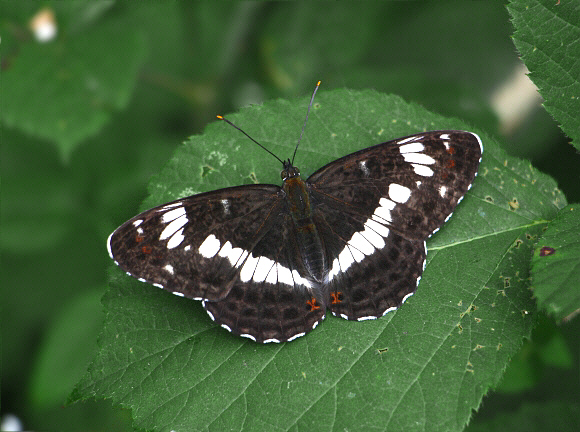 White Admiral Limenitis camilla, female, Hampshire – Adrian Hoskins
White Admiral Limenitis camilla, female, Hampshire – Adrian Hoskins
Introduction
There are about 25-30 species in the genus Limenitis. Some such as populi and camilla are widely distributed across Europe and temperate Asia. The majority however are largely restricted to China and the countries of the former Soviet Union.
The White Admiral is distributed across much of southern Britain and throughout central Europe but is absent from northern Scandinavia, most of the Iberian peninsula, and the Mediterranean region with the exception of western Italy. Beyond Europe it is found in Turkey, and across temperate Asia to north China, Korea and Japan.
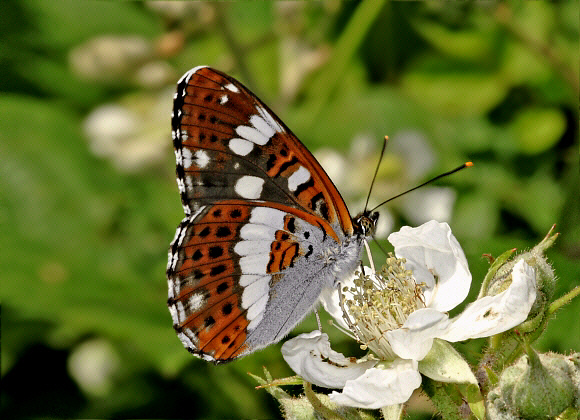
White Admiral Limenitis camilla, Alice Holt forest, Hampshire – Adrian Hoskins
The White Admiral can’t really be confused with any other British butterfly although novice butterfly-watchers sometimes mistake its silhouette in flight for that of the Purple Emperor Apatura iris which breeds in similar habitats and flies at the same time of year. Purple Emperors however are larger, with more pointed wings and a much more powerful flight.
In southern Europe and western Asia camilla can be confused with its close relative reducta but the latter has a prominent white spot in the discal cell of the upperside forewing, and only a single row of black spots on the underside hindwing.
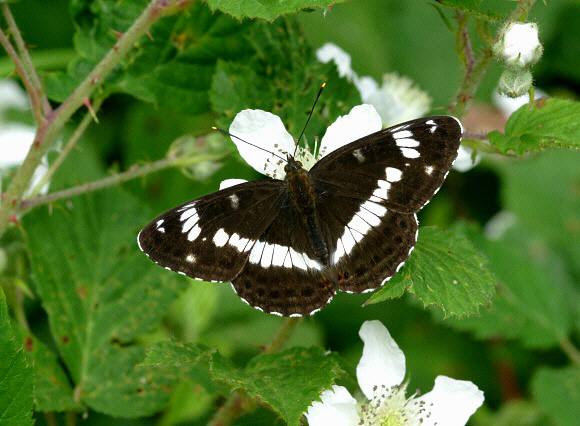
White Admiral Limenitis camilla, male, Hampshire, England – Adrian Hoskins
Habitats
In Britain camilla can be found in most broadleaved woodlands in the southern and central counties of England, but is commonest in Wiltshire, Hampshire, Berkshire, West Sussex, Surrey, Oxfordshire and Buckinghamshire.
Within these woodlands the butterflies inhabit small sunny glades, narrow grassy rides, and lightly wooded areas. It breeds in places where the larval foodplant honeysuckle grows in dappled sunlight, and hangs as thin wisps from the boughs of oak, ash and various other trees. White Admirals rarely venture away from these areas, and are not normally encountered in clearings, wide sunny avenues or dry open woodland.
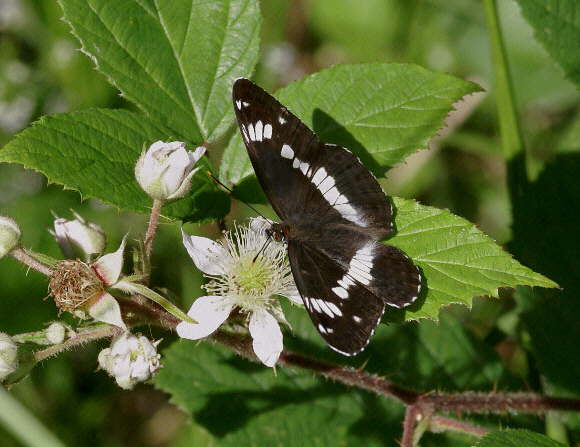
White Admiral Limenitis camilla, male, Hampshire – Adrian Hoskins
Lifecycle
The butterflies are normally univoltine, emerging in mid-late June. They have a lifespan of about 2 weeks. Late emerging females can still be seen until the end of July, and sometimes as late as early August. In exceptionally warm summers there may be a partial second brood in early autumn.
Females usually spend a minute or two carefully inspecting the vegetation at ground level, before entering the undergrowth to oviposit on leaves of Lonicera periclymenum. They meticulously select leaves growing semi-concealed in bushes or on the boughs of trees, always in dappled light or semi-shade. Luxuriant growth, or plants growing in sunlight are ignored.
The egg is globular, greyish-olive, and looks like a miniature sea urchin. The surface is covered with tiny hexagonal cells, and bears many short spines.
The caterpillars hatch after about 10 days. They give away their presence by leaving characteristic feeding marks – eating the tips of the leaves either side of the midrib but leaving the uneaten midrib protruding. The young larva disguises itself by covering its body with pellets of frass ( droppings ), and often rests at the tip of the protruding midvein. This appears to be a defensive action which has evolved to protect it from marauding ants. Many tropical relatives in the Limenitidinae take matters a stage further by constructing ‘frass chains’ by silking together pellets of frass along the protruding midvein. The tiny larvae habitually rest at the extremity, where ants are unable or unwilling to venture, possibly deterred by toxins within the grass.
In September, when in its second instar, the larva constructs a shelter by folding a half eaten leaf, which it fastens together with strands of silk. It spends the winter months hibernating within the shelter, and awakens in the following March to resume feeding, becoming fully grown in late May.
The mature larva is a beautiful creature, bright green with short dark orange spikes along the back and longer spikes on the front segments. It rests in a characteristic posture, with the tail raised and the front segments arched, and is extremely difficult to find in the wild.
The chrysalis is equally exquisite, having a purplish abdomen, bright green wing cases, and metallic silver spots on the back. There is a flattened knob projecting from the back, and a pair of long black labial knobs projecting from the head. It hangs suspended by the tail from a honeysuckle stem, and strongly resembles a withered leaf. The pupal stage lasts for about 2 weeks.
If the weather between late May and early-mid June is warm, the larvae and pupae develop rapidly, but in cool summers the rate of development is much slower. Consequently the time during which they are vulnerable to predation and parasitism is extended, and adult butterflies become scarce.
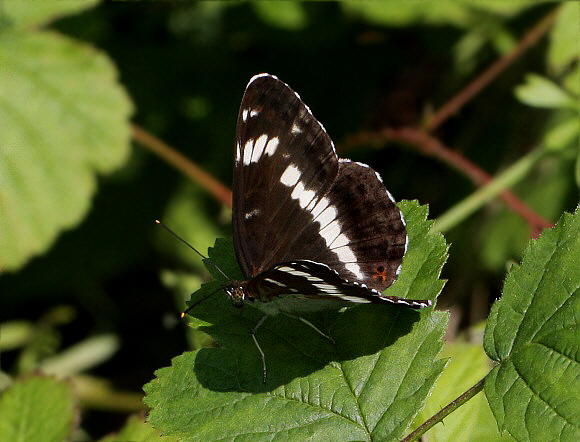
White Admiral Limenitis camilla, Fermyn Wood, Northamptonshire – Adrian Hoskins
Adult behaviour
The White Admiral is amongst the most graceful of butterflies in flight. Males glide high in the tree tops, then descend, flitting and gliding delicately and with great precision, in and out amongst the foliage in search of females.
On 16th June 2007, I watched 7 males flying around a small oak in a Hampshire wood, and noted that they frequently settled to feed at acorn buds. They also regularly visited the flowers of bramble and dog rose – White Admirals rarely if ever visit any other species of flower.
Both sexes, but particularly the males, also imbibe honey-dew from the upper surface of oak leaves high in the canopy. This sugary fluid is a by-product expelled by the oak aphid Phylloxera quercus, as it sucks protein-rich fluids from oak leaves. Vast quantities of this substance coat the uppersides of oak leaves in mid-summer. Rain washes the honey-dew off of the leaves, so after rainfall White Admirals and other honey-dew feeding butterflies tend to seek alternative forms of sustenance.
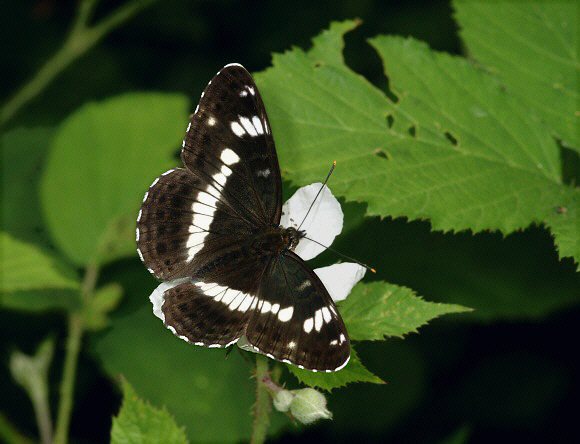
White Admiral Limenitis camilla, male, Hampshire – Adrian Hoskins
In hot weather males often descend to imbibe dissolved mineral salts from stony forest tracks, and I have seen them feeding on sticky fluids coating the stems of dock and other plants. I’ve also seen freshly emerged White Admirals drinking at frothy ‘cuckoo-spit’ ( froghopper secretions ) on twigs.
On overcast but warm days, the butterflies often spend long periods basking with wings outspread on the foliage of bramble bushes, bracken or hazel, or on leaf litter on the forest floor. They will fly even during light rain if the weather is warm, but when it gets really hot they seek shade, resting on the upper surface of heavily shaded foliage.
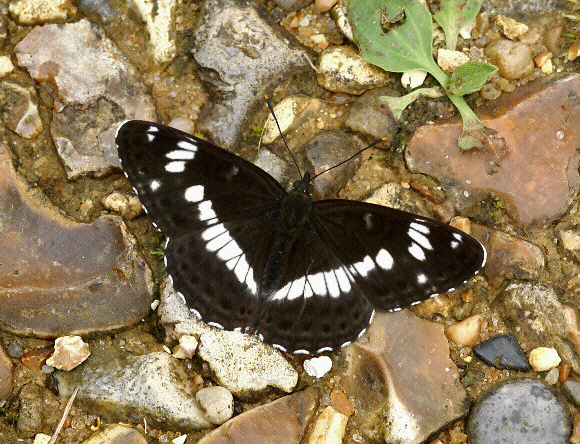
White Admiral Limenitis camilla, male, Hampshire – Adrian Hoskins
